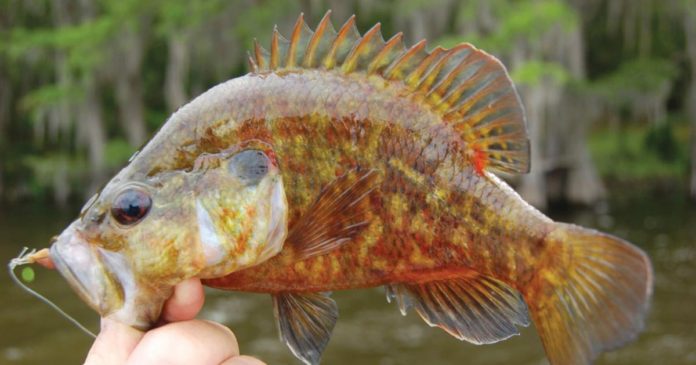I’m about to open a box of worms with this week’s column (pun intended).
I love catching and eating what I and most folks call perch or bream. Light tackle, a long shank perch hook, a box of worms and we are ready to go perch fishing, right?
Come to find out, to properly categorize the fish we are targeting, we are about to go fishing for sunfish.
Sunfish such as red ears (shellcrackers), warmouth, long ear, red breast and bluegill are all of the sunfish family, not perch as most of us have grown up calling them. I’m certainly not an ichthyologist, just a lifelong perch or bream angler. I can’t tell you the difference between a green sunfish and a long ear without looking at a picture but I can give some tips on catching sunfish, If we meet on the lake and I have a fish basket of scrappy little fish, I am likely to refer to them as bream. Oh, red ears and warmouth are easy to differentiate but others, for a layman like myself are just bream.
When sunfish go on the beds to spawn, usually in May and into June, catching is easy. Tackle is about as basic as it gets, a long shank hook (which makes hook removal much easier than with a short shank hook), worms or crickets or even pieces of light bread, an ultralight spinning rig and you are ready to fill your fish basket with some of the best eating in freshwater.
A fly rod rigged with a small popping bug is lethal when bream are on the beds and throughout the warm weather months during early morning and late in the afternoon when they are picking bugs off the surface. During the day, sinking flies such as small Clouser minnows will continue to provide action. During the warm weather months, bream head to deeper, cooler water assuming the oxygen level is sufficient.
My uncle Luke owned a fishing camp on an oxbow lake off the Mississippi river back when I was a boy and he loved bream fishing with his fly rod. But during the heat of summer, he headed out to deeper water and fished with live crickets for red ears. He would drift around until he found a school and often fill the fish basket in short order. He used to joke that if a shell cracker was as big as a bass, it would take a well rope to winch it into the boat!
Bream fishing, like most things in the outdoors can be as simple or complex as one wishes. Granted, fishing wet flies subsurface for suspended bream with a five-weight flyrod requires more skill than perch jerking using worms below a floater but who is having more fun, the youngster with his or her spin cast rig or the fly fisher with the $200 rod?
It’s all relative to one’s experience level. Personally, I prefer my lightweight flyrod with a small pencil floater, bream hook and floater for much of my bream fishing. I enjoy the fight a feisty bream gives me on my 7-foot lightweight flyrod, regardless if the fish is hooked with a popping bug, live worm or cricket.
Bream fishing is popular for many reasons. Finding a place to fish is easy and most bream are caught by anglers fishing from shore. Bank fishing is available at most lakes and city ponds. Farm ponds provide excellent fishing for sunfish of all species. A neighbor of mine has a deep pond that is spring-fed.
The pond is the result of sand and gravel mining decades ago and it keeps a constant level throughout the year, regardless of rainfall. When it gets really hot, I enjoy getting out at first light and catching bream on surface poppers and later heading to the deeper, cooler water and continuing the action using worms or crickets.
I have a few fishing buddies that kid me about taking the time to clean bream. There are two camps when it comes to dressing and eating bream. Many bream eaters believe their fish must be gutted and scaled and fried, tail on. I grew up eating sunfish in this manner but eating around the bones is definitely an art. These days, I much prefer to use a small-thin blade fillet knife and removing the fillets. The resulting fillet on an average size bream is about the size of a jumbo shrimp and to my way of thinking, equally tasty. My buddies that are all about fillets from bigger fish are usually the last to pull away from the table after a big perch fry.
While I usually fry catfish, crappie or white bass in a mixture of one cup flour to two cups cornmeal, I just dust my bream fillets with flour, after lightly seasoning them with a mixture of black pepper, salt and garlic power. It takes no more than a couple minutes in hot cooking oil to turn out a crispy bream fillet. Whole bream can be cooked to perfection in four or five minutes. These little fish cook quickly and it’s important not to overcook them.
Regardless if you are a veteran angler or someone wishing to just go fishing and catch lots of fish, try catching these feisty little battlers on light tackle. They are plentiful just about anywhere there is fresh water and the best is yet to come once you have them cleaned and exposed to Lake Crisco!
Email Luke via his website www.catfishradio.org.
Credit: Source link































